












When I started at this company many years ago, I admit I understood very little about what the reserve component does. My entire adult life has been attached to the active-duty side of the house, so I slowly learned one story interview at a time how uneducated I was. And I’m not alone in that ignorance of assuming the commitment was only one weekend a month, two weeks a year.
In the years after 9/11, the Department of Defense and U.S. relied heavily on members of the National Guard and reserves in a range of capacities; from responding to natural disasters to serving on the frontlines, helping to fight a pandemic and responding to civil unrest in the wake of protests. Every facet of this country’s domestic and international needs has been filled by you. As Gen. Joseph Lengyel told me, there will never be another war fought without reserve forces.
So, the question becomes: when will the support catch up to the increased responsibilities?
In our editorial work, we often struggle to find support programming that doesn’t have an asterisk attached, eliminating a good number of you from qualifying. Research has shown that the aftermath of service doesn’t always show itself in X amount of days after homecoming. One thing the active-duty force does well is advocate for itself, whether that be after leaving the service or a
community of spouses who elevate their voices until they are heard. We want to hear from you. What’s working and what isn’t? What antiquated way of doing things needs to be brought into presentday realities?
Submit your story to us at https://reservenationalguard. com/submit-your-story.
New York Army National Guard Sgt. 1st Class Joseph Maloney is among nearly 100,000 soldiers and airmen who have mobilized in recent months for multiple missions across the United States.


THIS
Stephen Ruiz
John Gronski
Jessica Manfre
Crystal Kupper
Natalie Gross
Dave Paone
Susan Malandrino
Photo by 1st Lt. Lauren Warner.The Reserve & National Guard is published six times a year for reservists and members of the National Guard. Copies are available through participating Reserve and National Guard training centers at no cost.

Unit distribution requests can be made online at: AmeriForceMedia.com/rng/print-magazines/ Individuals can order a free digital edition of this guide at: AmeriForceMedia.com/rng/subscribe-free/ Editorial comments can be emailed to: managing.editor@ameriforcemedia.com
The Reserve & National Guard by AmeriForce Media is published by AmeriForce Media, LLC, Bloomington, Ind., a private company. Information and advertisements in this publication do not constitute endorsement by any branch of the military or the Department of Defense. No part of this publication may be copied without the express written permission of the publisher. AmeriForce Media, LLC, the publisher, and publisher’s agents make no endorsement of any advertised services or products and none should be inferred.
President and Publisher Todd Taranto
Managing Editor Bianca M. Strzalkowski
Design Open-Look Business Solutions
ADVERTISING
PLEASE CALL 703-337-8100
Todd Taranto Publisher
Todd.Taranto@AmeriForceMedia.com
Julie Miller
Vice President, Sales

Julie.Miller@AmeriForceMedia.com
Brian Dunbar
Director of Business Development
Brian.Dunbar@AmeriForceMedia.com
Ursula Hirschhaeuser
Germany Sales +49 (0) 69-15053980
Ursula-Hirschhaeuser@t-online.de

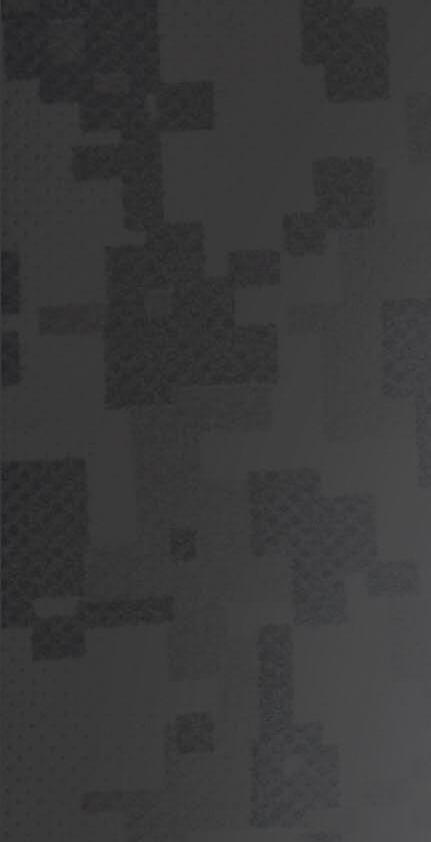
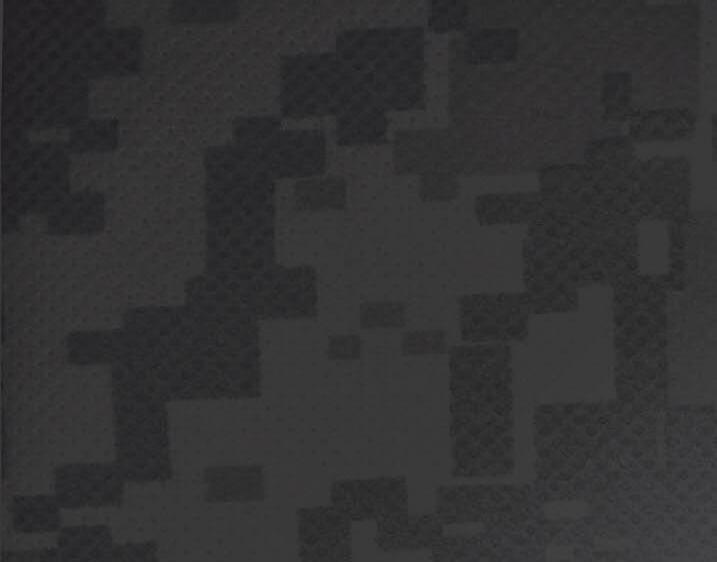




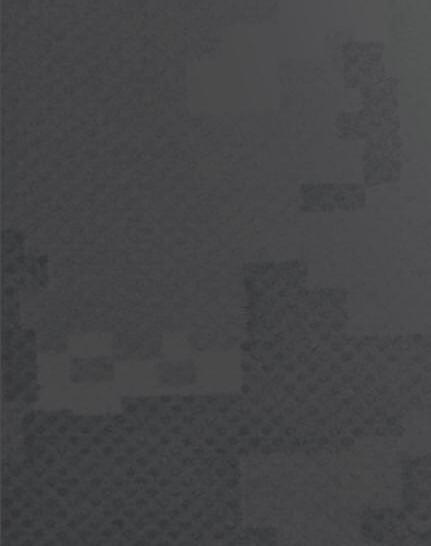






































 By Stephen Ruiz
By Stephen Ruiz
Lt. Col. Christopher Messina said the 12,000 members of the Tennessee National Guard are no different than the people they serve.
“We’re your family and neighbors,’’ Messina said. “We work with you. We celebrate with you, and we suffered with you.’’
Nearly 40,000 National Guard members have been dispatched in every state, three U.S. territories and the District of Columbia because of the COVID-19 pandemic. As of June, the virus has killed more than 106,000 Americans, and almost 1.85
million have tested positive, data from the Johns Hopkins Coronavirus Resource Center showed.
Then came the death of George Floyd in May, after Minneapolis police officer Derek Chauvin pressed his knee into the back of Floyd’s neck for almost nine minutes, sparking national outrage. Video of the incident ignited protests for social justice and against police brutality, prompting the National Guard to send thousands to 31 states and Washington, D.C., at the time of this reporting.
National Guard officials in several states said the civil unrest has not compromised their units’ response to COVID-19.
“The California National Guard is able to support both missions right now,’’ Lt. Col. Jonathan Shiroma said. “… Is there a challenge? I don’t know if challenge is the right word. What makes this a bit more personal is that this is all happening within our own state.’’
An unprecedented 96,521 soldiers and airmen mobilized for current domestic missions, the National
Guard Bureau said in a news release, surpassing the roughly 51,000 Guard members who were activated for Hurricane Katrina in 2005.
“The biggest impact it has is on the staffs that are doing the planning for all the different events that are going on,’’ Col. Matthew Woodruff, a Joint Task Force commander with the Ohio National Guard, said. “As far as capabilities, it really hasn’t reduced our capabilities.”
Ten states sent National Guard members to Washington, D.C., to assist in maintaining peace. At the height of operations approximately 4,000 from the District of Columbia and supporting states were in the National Capitol Region — including 1,000 from Tennessee, Messina said.
“We respect and uphold the right to freedom of speech,’’ Messina said. “We deter all acts of violence against our communities, so we’re here … We’re truly citizen soldiers.’’
In Florida, four of 28 coronavirus testing sites were closed for a day as the National Guard moved some members from the COVID-19
mission to support security efforts during protests.
“However, that was on a Sunday, … and traffic is generally very light,’’ Florida National Guard spokesman William Manley wrote in an email. “The time allowed for planning was minimal, but fortunately, we’d done some of the civil-unrest planning at the beginning of COVID-19 operations and were able to apply that.’’
Whether it is because of the pandemic or Floyd’s death, the public’s response to the National Guard’s presence has been mostly positive. Messina mentioned a scene in Nashville, Tennessee, this week, in which guard members lowered their riot shields at the request of protesters.
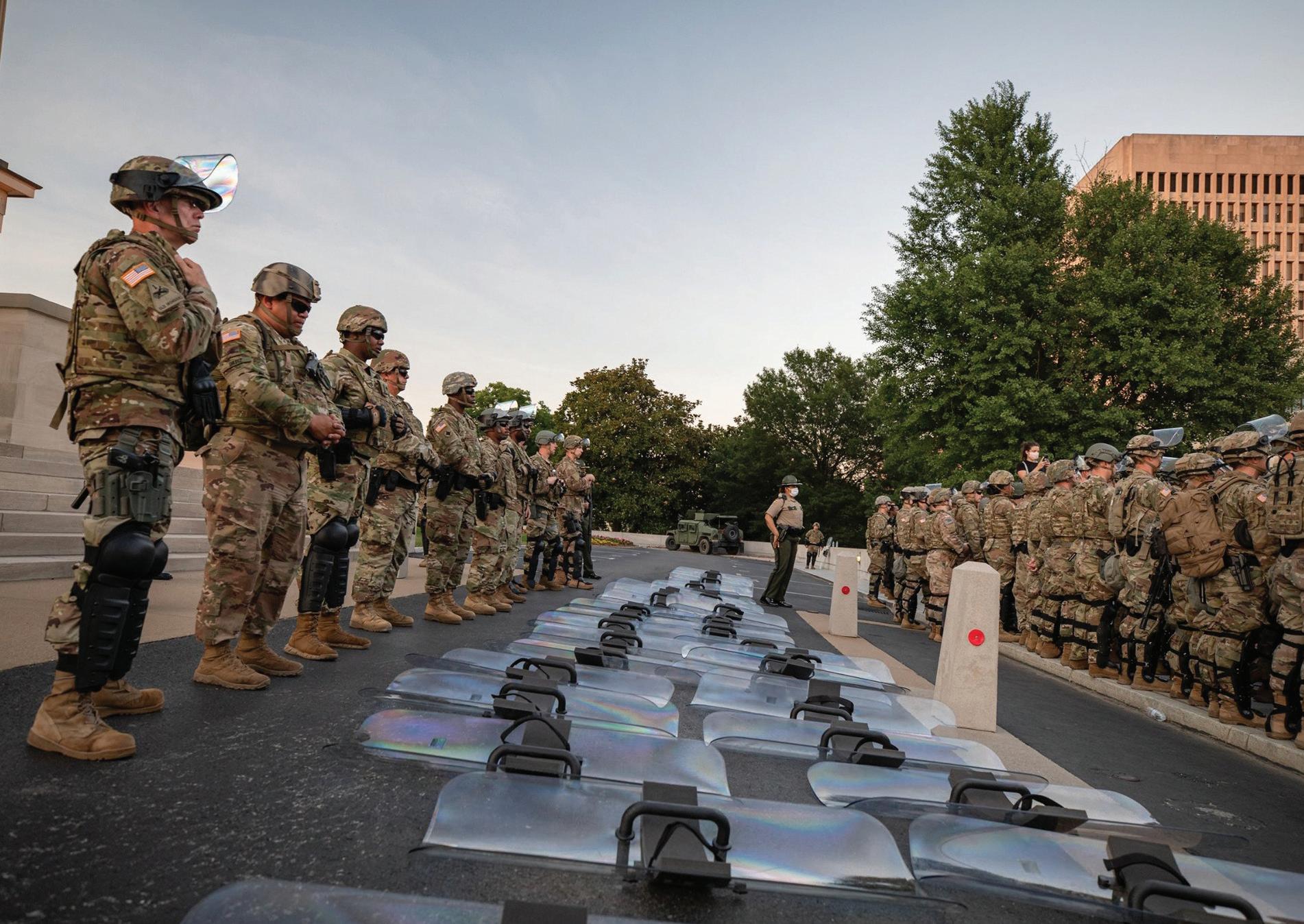
“It changed their attitudes and behaviors dramatically,’’ Messina said.
At the time of reporting, charges against Chauvin in Floyd’s death were upgraded to second-degree murder, and the three other officers at the scene were charged.
The cases against the officers are far from over, as is the National Guard’s work on the front lines of two major events.
“It’s not just difficult to see the issues that we’re experiencing through the civil unrest,’’ Woodruff, of the Ohio National Guard, said. “The amount of need that we’ve seen throughout the state in the last several months is trying.’’
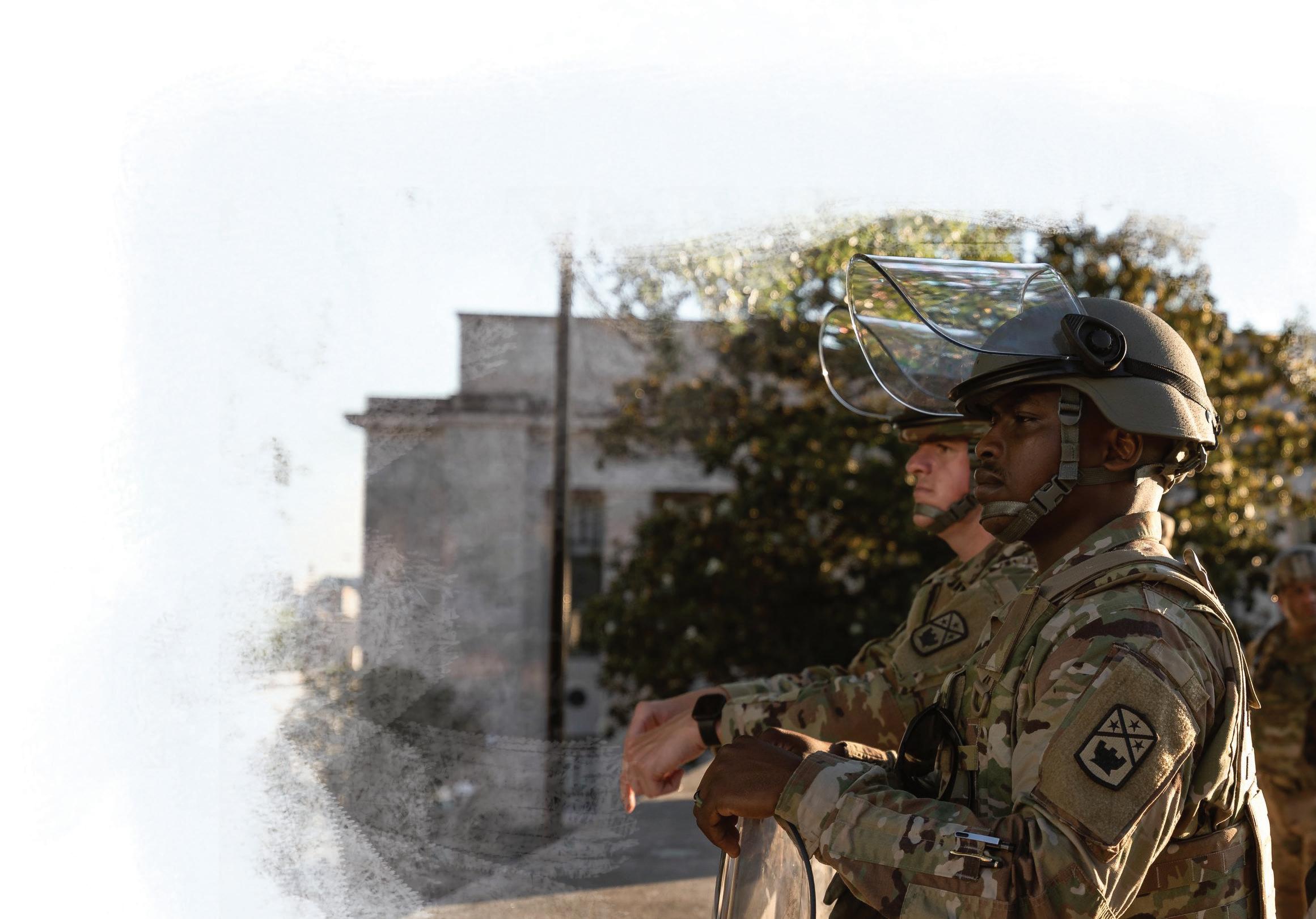
VA Women’s Health Transition Training is a collaborative effort between the Department of Veterans Affairs and the Department of Defense to educate service women on women’s health care services available after separation from the military. This course provides an indepth discussion about:
Female specific health care including reproductive services, maternity care, mental health services, newborn care, and gynecological care and musculoskeletal care.
Eligibility for VA health care and how to enroll.
Resources available for servicewomen during the military to civilian transition process.
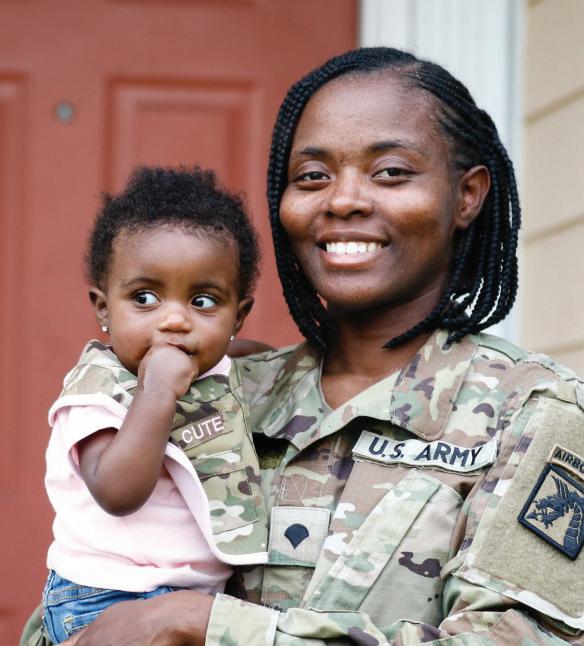
As COVID-19 interrupted the upcoming schedule of in-person sessions, the training team transitioned to a condensed virtual format that allows attendees to engage with an instructor in real time. The two-and-a-half-hour period is divided into five phases.
Dr. Nancy Maher, program manager of VA Women’s Health Transition Training, says the live classroom setting still contains core elements such as differences between the military and VA healthcare systems.
“We talk about how in the military healthcare system everything is regimented, like ‘you will come in at this date and time to have this vaccination’, etc.; whereas when you’re in the VA, it’s more like the private sector in that the onus is on you to seek out your healthcare and adjust your healthcare needs,” Maher said. “Then we do a really deep dive for healthcare services available for women at the VA: reproductive health, primary care, specialty care and getting really deep into the benefits in terms of infertility treatments, adoption, etc. and … some of the deployment healthrelated conditions that service women might experience more frequently than their civilian counterparts.”
Because of the comprehensive nature of the topics, there is a companion workbook with further explanation on services.
It is recommended training be completed within a year of when a service member anticipates leaving the military, but Maher said “we don’t want it to be too far out where they lose that information.”
A bonus feature of the virtual format is a women veteran’s program manager is available during the training to answer any questions and provide additional insight. These WVPMs have unique knowledge on the services and offerings to women by women, and they serve as advocates. Maher sees added benefits in the women-only class.
“(It) allows for a freer discussion and a more safer environment where people can really discuss gender-specific healthcare issues and needs,” she said.
All service women are encouraged to register and attend any virtual training. Participants are not limited to trainings in their own time zone.
There are over 800,000 reservists serving this country. Their role and responsibilities have shifted significantly over the last 20 years, but even more so as a result of the recent COVID-19 pandemic. Navy Reserve Lt. Bryan Bergjans is experiencing it firsthand.
“You have a lot of different stressful situations with your sailors and soldiers in general. They are feeling it from about 45 different directions. It is an extremely challenging time to be a reservist,” he said.
Bergjans explained reservists have responsibilities that vary from active-duty counterparts because typically reservists work full-time civilian careers in addition to military service — a commitment far different from the one weekend a month stereotype.
“Since 9/11, people have developed a huge respect for the reserve force,” Bergjans said.
He added those in the reserves can be deployed at any time, having to leave their civilian careers behind at a moment’s notice, which includes his own experience of getting notified about a deployment to Afghanistan with the Navy.
Bergjans says the days of simply drilling one weekend a month are long gone.
“It’s not part time anymore. Depending on what unit you are in now, the demand is so high and so is the potential for deployment,” Bergjans explained.
Plus, with the recent pandemic, many reservists are being furloughed and even losing their full-time employment completely. Bergjans praised the reserves, saying that they stepped up and found ways to not only support military readiness, but continue to provide income to their reservists.
“They clearly recognized that a big chunk of their force was getting hampered on the civilian side from an income perspective. They were willing to go outside of the box in a telework environment so at least their folks were getting paid,” he said.
Relief organizations from every branch of service committed their support to service members and their families impacted financially due to the virus. Reservists and members of the National Guard were included in the expansion of financial support.
Although many would assume reservists often receive the same level of support, they would be wrong.
“We get stuff trickled down to us,” Bergjans said.
It is why he recommends reservists educate themselves on what is available to support them, including things like benefits, insurance, and financial management.
Bergjans wasn’t even aware he could utilize the VA home loan benefit as a reservist when he and his wife purchased their home in the early 2000’s. His mortgage company was also uneducated about it, despite knowing he was in the military. This past homebuying experience led to his currentday commitment of ensuring service members have access to education on their earned benefits.
Despite having a successful career at Caliber Home Loans as their senior vice president of military lending, Bergjans plans to continue his Navy service as long as possible.
Visit https://www.caliberhomeloans.com to learn more about the company’s commitment to the military along with special assistance for those impacted by COVID-19.
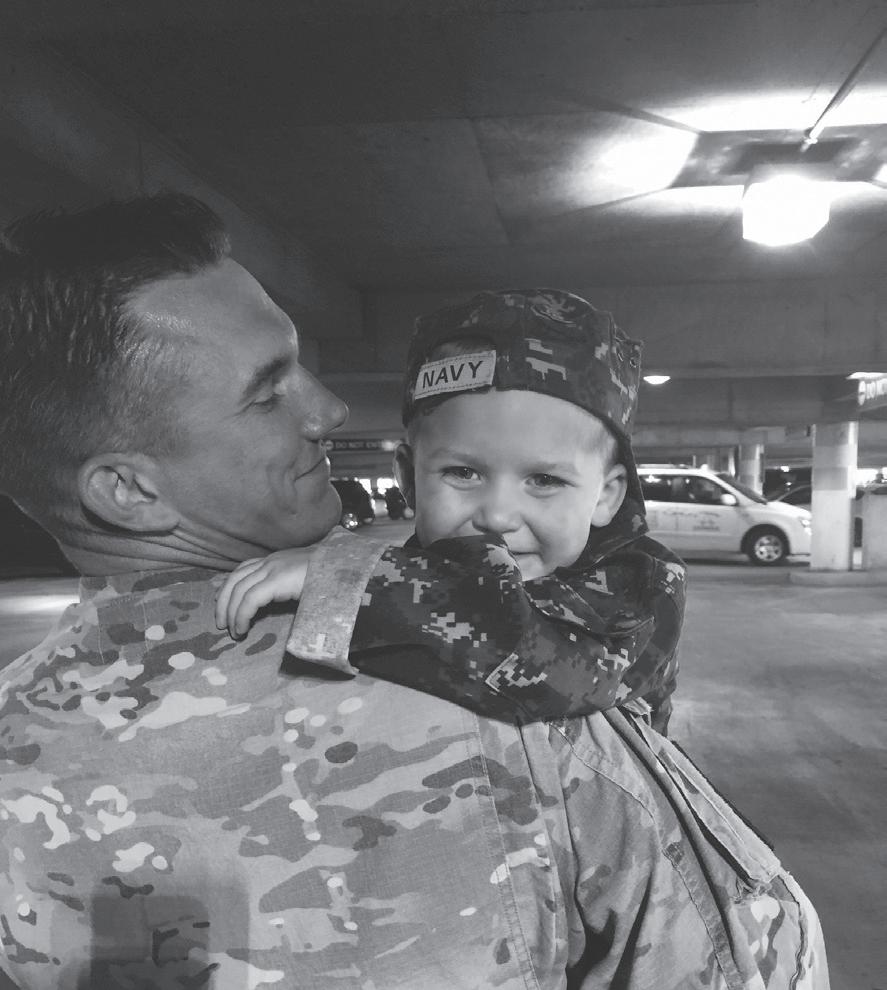

 By Bianca M. Strzalkowski
Jorge Rodriguez, the 1,095th and final COVID-19 patient was treated and released at the Javits Medical Station and received a sendoff by the COVID-19 responders.
By Bianca M. Strzalkowski
Jorge Rodriguez, the 1,095th and final COVID-19 patient was treated and released at the Javits Medical Station and received a sendoff by the COVID-19 responders.
The American public watched as the National Guard filled highlyvisible roles throughout the coronavirus response for testing patients, distributing meals and setting up field hospitals. The lesser-known story is that of soldiers like Sgt. Guiseppe Vignolesi who had the grim task of aiding Guardsmen in processing the death stemming from COVID-19.

Vignolesi, 30, is a religious affairs NCO with New York Army National Guard. He provides spiritual guidance, counseling, and mental and morale welfare. After being activated in late March, his job was to assist on calls for recovery of “the unattended.”
“Our responsibility was to do recovery of the remains, so we would go out on calls with the medical examiner’s office — we would be assigned a medical examiner — we go to residences, apartment buildings, nursing homes, hospitals, morgues, and project housing and we would go retrieve the remains of those that were deceased for both COVID and non-COVID,” Vignolesi said.
In his civilian career, Vignolesi works in law enforcement so this type of work is not uncommon, but he was cognizant of the fact that many of the Guardsmen were brought to the frontlines untrained for what they would see.
“My role was to provide mental welfare for those soldiers and how I could do that in a unit is I have to get out there with them. On the civilian side I’m a first responder, I work in law enforcement so it’s (death) something I had already experienced,” he said. “Basically, just get out there with them (soldiers) and do the recoveries
and really try and engage with leadership and make sure you look to your left and your right; make sure everybody’s OK because not everybody’s a first responder, not everyone had ample training leading up to this. People from all walks of life from the civilian side — electricians, mechanics, people that work in fast food service — people who weren’t prepared or ready to do this sort of work got thrown into the frontline of this.”
By June, NYNG personnel had assisted in recovering 2,834 remains, according to Eric Durr, director of public affairs.
At the peak of the COVID-19 mission, New York had 3,600 members activated from the NYARNG, New York Air Guard, New York Naval Militia and New York Guard, Durr stated. Among them, Spc. Elyse Jones who describes the scenario as comparable to “nothing” in her life.
Jones is a medic that was assigned to the Alpha Company Strike Team
at the Glenn Island testing site.
“I did anything from preventative stuff with them, keeping an eye on them, treating any small issues and then referring them to a medical provider at Camp Smith if they needed to be seen by someone. We also were responsible for checking vital signs for all of the employees, so we did temp screens in the morning and then everyone had to go through the vital stations before and after their shifts to make sure they were staying healthy and make sure nobody was popping a fever during the day,” Jones said.
Her unit received ongoing training at all stages of activation regarding their own safety, she says. Items like donning and doffing PPE were continually enforced.
As prominent as COVID-19 has been in recent months, it did not slow down other commitments required of Guardsmen including deployments. Jones’ home unit is anticipated to deploy in the fall, something that weighs on her
mind as she experienced a taste of what it’s like to be separated from her family. Albeit for a much shorter time period, she said it was the hardest part of her stateside mission.
“More than anything probably just being away from my family, my son, my dog. That was the hardest part knowing I was still somewhat close but also just knowing that I needed to be responsible and not be running home on my days off because I was potentially being exposed to the virus all the time, but also just to not wear myself down so I would be fit for duty every day,” Jones said.
She adds that as much as the unexpected is a known part of the job, the “uncertainty” of this mission felt different.
“Just speaking for myself personally, because I’m still new to the Guard, but then after working with some of the people I worked with, I think that this response happened — because it had to — so suddenly that I think it was a kind of adjustment, it was unexpected. Usually if you go on active-duty orders, from what I know, you have kind of set dates to start and end. ... It is new and different for everyone to not have a true sense of when they’re going to essentially be off orders, but also the way in which everyone got activated and not knowing what they’re returning home to. All that uncertainty,” she said.
New York remained a coronavirus hot spot with statewide numbers reaching 383,944 at the time of reporting, according to Governor Andrew Cuomo’s website . For those native to the state, large-scale events are not new, says Sgt. 1st Class Joseph Maloney, but its far-reaching impact was.
By the NumbersThe COVID-19 mission was historic in that the number of activated members from the Air and Army National Guard exceeded the previous record from Hurricane Katrina. In addition to the individual stories of contributions from those attached to New York National Guard, below is a snapshot of how units supported state governors:
190 Million:
Masks, gloves, gowns and other personal protective equipment distributed.
149.3 Million:
Meals packaged, served or delivered by Guard members.
2.4 Million:
People tested or screened for COVID-19 virus by Guard members.
 Sgt. 1st Class Jonathan Morrison, a combat medic specialist from Brooklyn, N.Y., assigned to 24 Civil Support Team Weapons of Mass Destruction, 53rd Troop Command, processes a COVID-19 test at a rapid mobile testing site located at the Jacob Javits Center field hospital. Photo by Sgt. Michael Bezares.
*Information obtained from the National Guard Bureau
Sgt. 1st Class Jonathan Morrison, a combat medic specialist from Brooklyn, N.Y., assigned to 24 Civil Support Team Weapons of Mass Destruction, 53rd Troop Command, processes a COVID-19 test at a rapid mobile testing site located at the Jacob Javits Center field hospital. Photo by Sgt. Michael Bezares.
*Information obtained from the National Guard Bureau
“I think each time is unique in its own way. My first mission was Ground Zero so that is different on its own and then overseas deployment. Superstorm Sandy. This one was a little bit more unique because it affected everybody and not just certain areas,” Maloney said. “I think it affected a lot more people personally.”
Maloney, a human resources NCO, enlisted 20 years ago after being attracted to the dual-mission of the Guard supporting stateside and overseas needs.
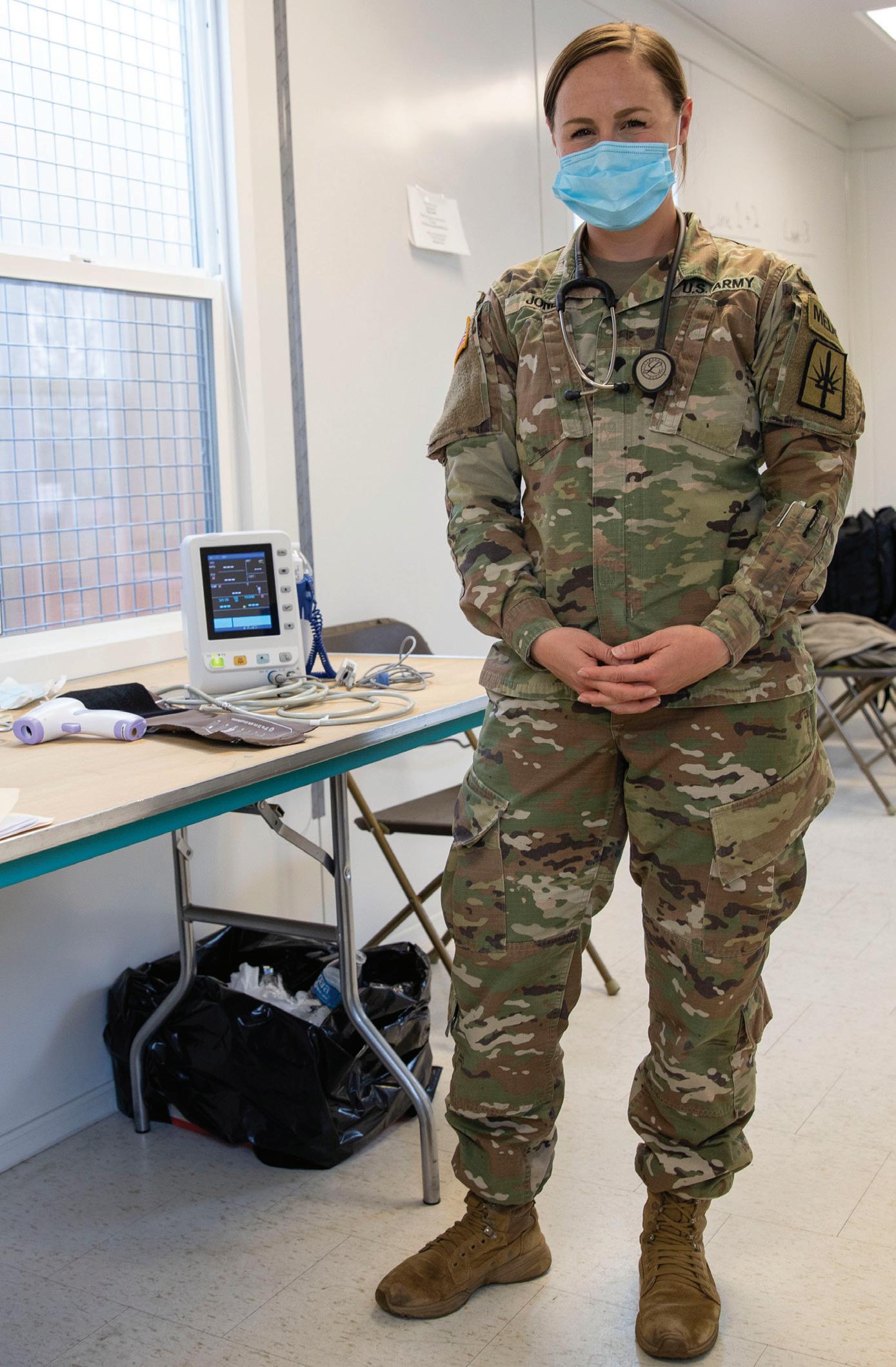
“When I was in high school, I really enjoyed the idea of helping people out. I heard about the National Guard and saw them on TV. I also liked the idea of serving,” he said.
He was initially brought in to the pandemic response for a different mission, but it was called off. He says he and a few others sought permission to aid at the Javits Center in New York City.
“We helped in areas that we have some background in, so I fell in with a safety team providing safety — not so much security — but safety of the building as far as slowing the spread of the virus, soldier safety, civilian safety, patient care safety,” Maloney said. “The day to day was ensuring patient care. … When you walked in there (Javits Center) you knew you weren’t there for you, you were there for them (patients), whether they were in the ICU or the general COVID center. Your focus was ensuring that they get better and then that everyone supporting the mission stays safe.”
He also says the overall role the Guard has played around the country in fighting the virus reinforces its value.
“I preach the Guard because of our missions. Our mission is all over the board and we have to be able to adapt so quickly and who would have thought there would be something along the lines of a virus coming through this country and the Guard would have to help fight it. The broad range of the Guard mission is amazing. I think
that’s why people join the Guard, we’re able to join the fight wherever needed,” Maloney said.
At the time of publication, 84,000 remain engaged in homeland and overseas missions. President Trump extended National Guard Title 32 orders into mid-August, according to a FEMA release.
Education opens doors.
Maj. Gen. Anthony Carelli, adjutant general of Pennsylvania National Guard, says the education he received starting at the Air Force Academy set him on a path to build his future — and under his leadership the same opportunity is being afforded to families in his unit.
Pennsylvania Governor Tom Wolf signed the PA GI bill last year, creating a program that allows spouses and children of Pennsylvania National Guard members to attend college at no or reduced cost. The Military Family Education Program (MFEP) is a first of its kind in the U.S.

“Pennsylvania National Guard members and their spouses and children give a tremendous sacrifice to keep residents safe. These families endure hardships that include many sleepless nights away from one another during overseas deployments, training exercises and domestic emergencies,” Wolf
stated in a press release. “The Military Family Education Program is a fitting way to pay tribute to the families who give this selfless support.”
Under the PA GI Bill, PNG members who commit to an additional six years of service can receive five years of higher education benefits for their spouses and children. The program will provide for 10 semesters of tuition-free education for family member(s). The benefit
must be used at a Pennsylvania Higher Education Assistance Agency-approved educational institution, and at the tuition rate set by the Pennsylvania State System of Higher Education, according to the governor’s website.
Carelli said education opportunities often serve as a tool to get men and women through the military’s door, but they stick around because of the culture.
“We have so many people that join just because of that benefit … they serve for six years and they understand what this organization does; they understand what it’s like to give back to your commonwealth; what it’s like to serve your country and … a lot of those people who fully intended to get out after six years, we’re keeping them,” he said.
But he also recognized that just as Guard members have an interest in college, there is a financial burden associated with sending multiple people in one household to school. It’s how the idea came to be for a family benefits program.
“ … many of our members when they deploy and go on active duty, get the 9/11 GI Bill — and they
Gov. Wolf signed a bill in 2019 extending education support to families of Pennsylvania’s Guardsmen.pass it to their kids. That pays for one education, then we see them struggling to pay for other family members and that’s what gave us the idea for this Military Family Education Program. It’s like, what if Pennsylvania did a program where, for another re-enlistment, we’ll pay for another family member’s education — or you can split it up however you want,” he said.
Carelli said he is pleased with how fast the bill was passed because so many were eager to utilize it. As of April 2020, 1,768 MFEP applications from Pennsylvania National Guard members have been approved. Joan Zlogar Nissley, communications director for PA Department of Military and Veterans Affairs, said she anticipates “this number will grow steadily since the MFEP benefit will be available for use by dependents during the 2020/2021 Academic Year.”
Carelli says he watched as his own peers struggled to pay back debt for many years after completing school, and Pennsylvania’s program enables “people to get through school with no student loans and no bills, not being in debt.”
“We’re able to give our Guardsmen an opportunity to get out from some of that debt and concentrate on serving and all the sacrifices that it takes to serve but not make another sacrifice to support your family,” Carelli added.
Visit
Like many of our military students, we are in the field every day, working, learning, adapting. As the leader in industries such as fire science, criminal justice and emergency medical services, it is imperative that we stay connected to our communities and those we serve. We are more than educators. We are public servants. For us, flexibility isn’t just a benefit, it is a requirement.
Our Commitment to Serving Military Students and Their Families Includes:
» Tuition Assistance
» Tuition Rates Below DoD Cap
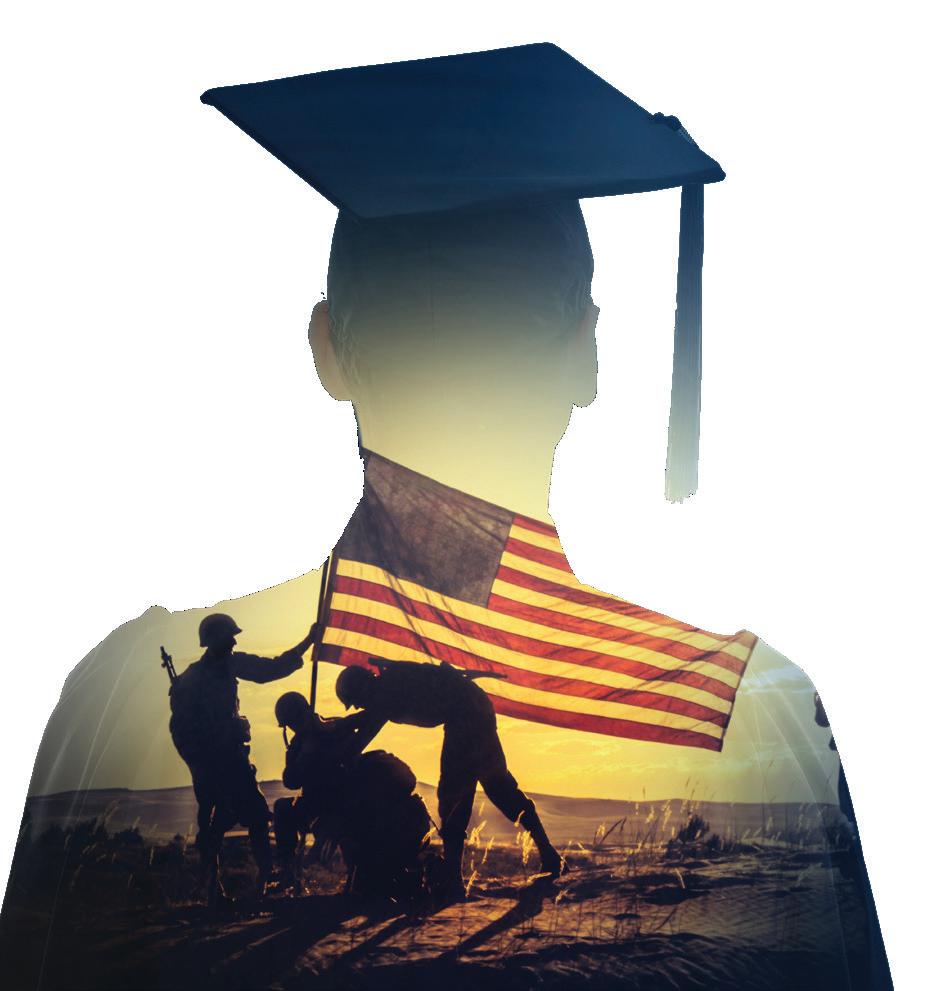
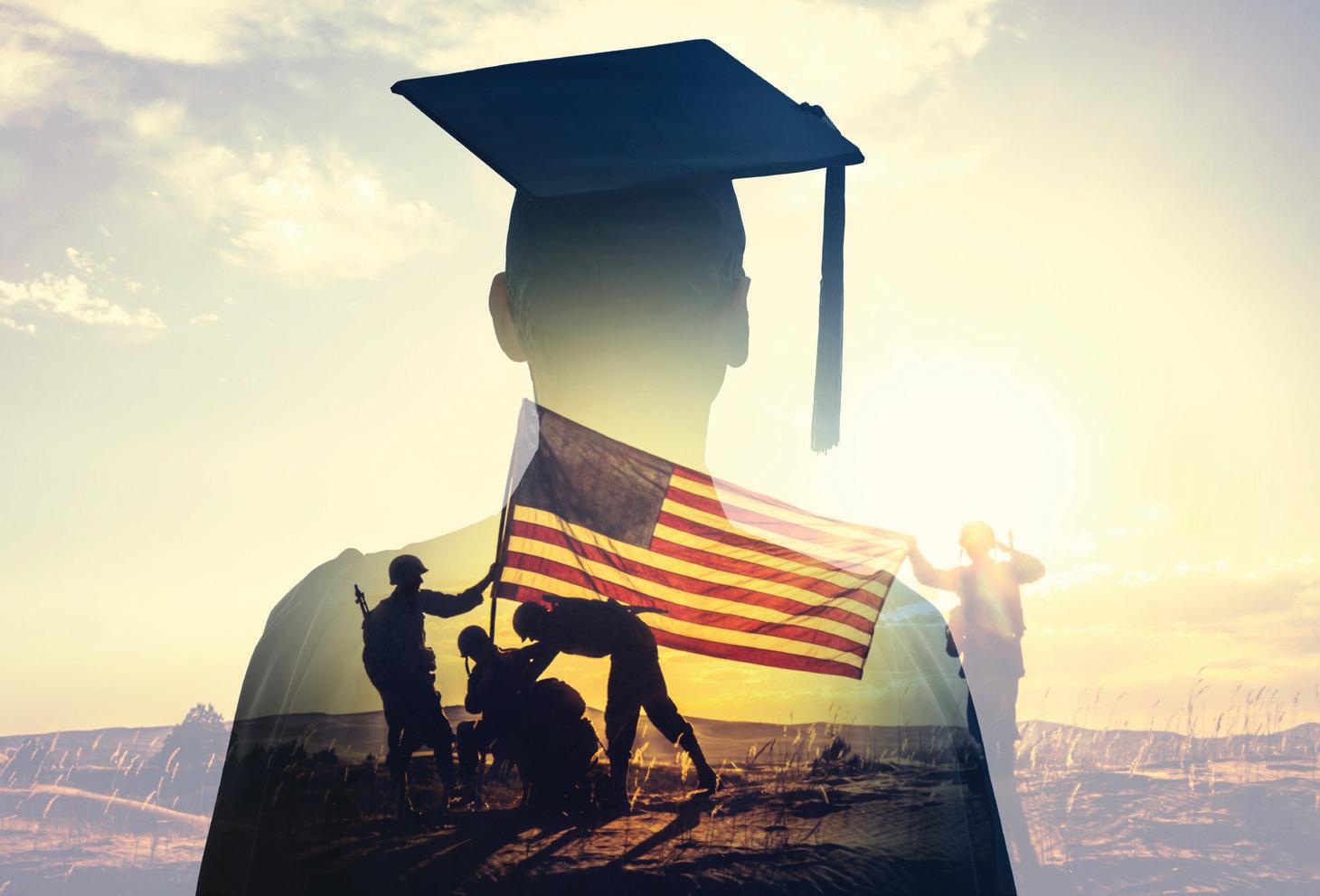
» Military Training Credits
» Scholarships for Spouses and Children
www.reservenationalguard.com 15
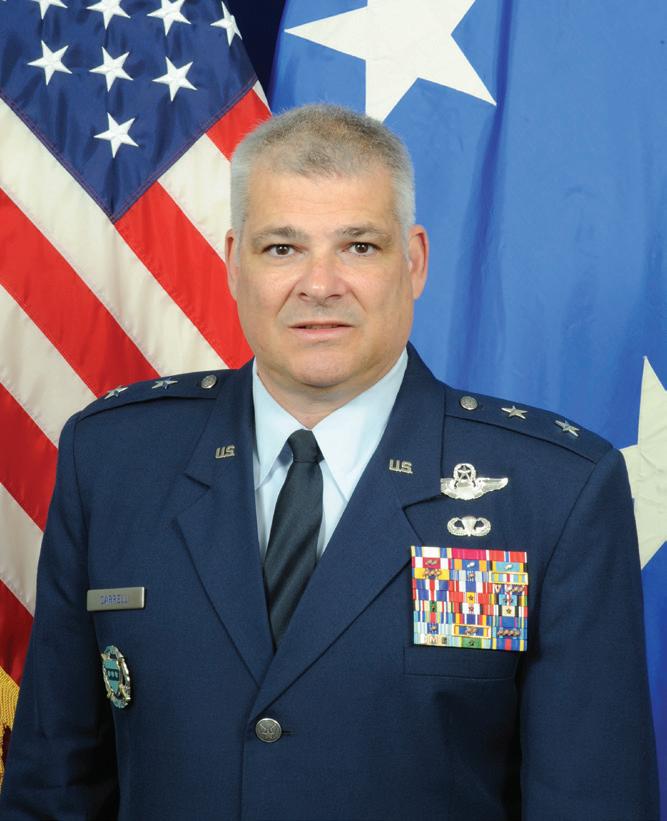
A program that trains participants for a post-military civilian career has moved online.
Onward to Opportunity, a program offered through Syracuse University’s Institute for Veterans and Military Families (IVMF) for members of the National Guard, reserves and military spouses, offers training in technical and soft skills with over 40 different career training programs and certifications.
“Program participants now can earn free certifications for in-demand career fields including information technology, project management and human resource management in classes that run on a quarterly basis,” Mike Bianchi, IVMF Senior Director of Education and Career Training, said.
Before coronavirus upended traditional classroom learning, O2O was online and present at 19 military installations. For now, however, it’s exclusively virtual. Accepted participants can choose classes like Google IT Support, Business Management, Database Management, Cloud Services, Customer Service and more — with no tuition or textbook fees.
Formerly known as the Veteran Career Transition Program, O2O was established in 2015 with support from the Schultz Family Foundation to combat the then-16% unemployment rate for veterans.
“The shift online will positively impact tens of thousands moving on from the military. IVMF has marshalled its expansive technological resources to ensure those transitioning out of the military have the resources they need in a dire economy to step out of the military into successful employment positions,” according to a recent IVMF press release.
More than 12,000 have been enrolled, with O2O boasting a roughly 75% job placement rate for graduates.
“I believe the true benefit of the program is finding out what you would be happiest doing, which made the transition from the military much less daunting,” JeanCarlos Hernandez, a former Navy lieutenant, said. “I had a general sense of what I wanted and the program helped me more clearly identify where I should be focusing my attention for a new career.”
O2O’s in-person classes consisted of three to four eight-hour days for each learning module. By contrast online sessions have been condensed to about four hours a day.

“We’ve also relaxed course requirements for the time being,” O2O National Program Director Michael Schoeneck said. “There are a lot of people at home now with kids. We’re sensitive to that, but we also maintain a high level of delivery.”
O2O also has a strong relationship with Hire Heroes USA, a veteranfocused nonprofit with connections to over 850 national employers who are actively seeking veterans as new hires.
“Distance learning services are needed now more than ever, because transition is always a time of uncertainty, and COVID-19 has introduced a higher level of uncertainty,” Schoeneck said. “We want to make sure that we are supporting transitioning service members, veterans and military spouses.”
For more information on O2O, visit: Getting Started – Onward to Opportunity.
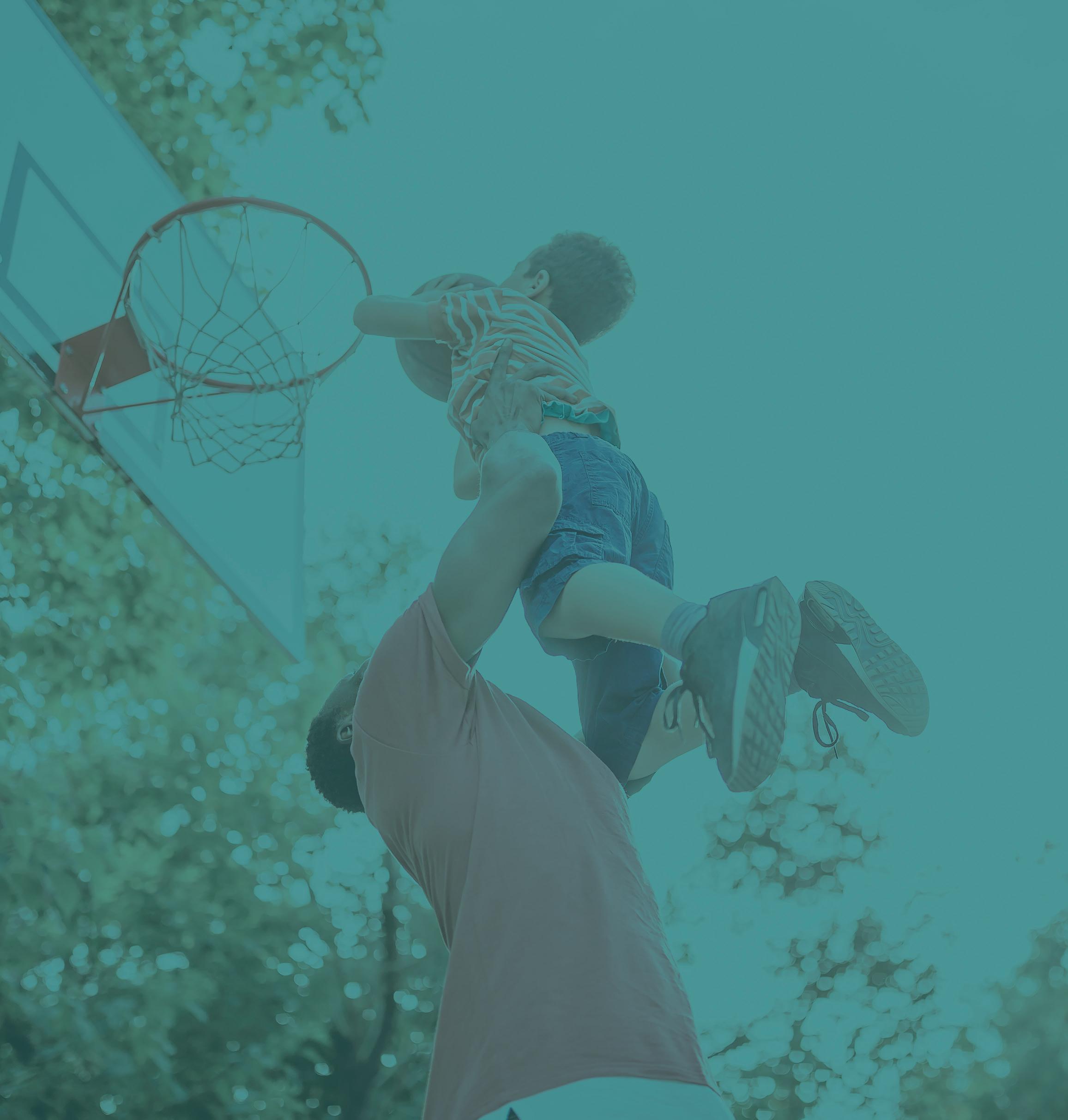
When Army Reserve Maj. Clay Keel is in uniform, he plans military medical operations by organizing personnel and logistics as part of the Army Medical Service Corps. Off duty, he runs the Keel and Curley Winery and Keel Farms Agrarian Ale + Cider brewery in Plant City, Florida.
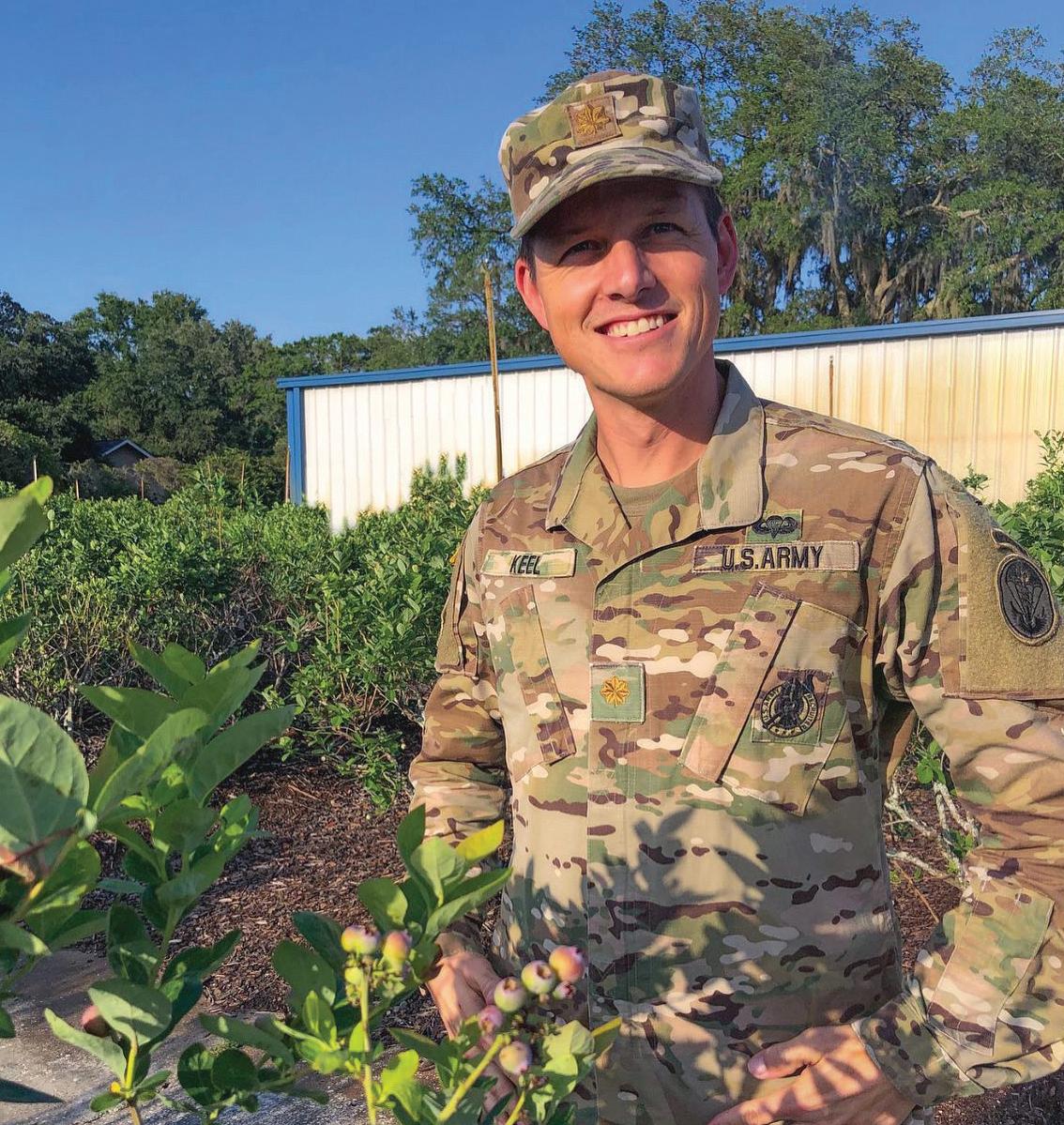
In many ways, the two jobs aren’t so different. Both require problem solving and teamwork skills that service members learn early on, Keel said.
“The further up you go, the more civilian the training kind of becomes,” he said. “You start learning about how to make decisions, how to allocate resources and plan for resources, and then you go beyond that … where the Army teaches you about strategy.”
For small business owners like Keel who serve in the military part time, continuing their service while also running a brewing business can be rewarding — a way to stay connected to the military while also pursuing entrepreneurial passions.
“In my Army Reserve career, I’m never going to be a general because I’m not putting in the time and doing those really challenging jobs that are going to lead me to that. But I’m still able to serve in a role that takes a less amount of time, or at least it gives me more flexibility,” he said.
Keel’s father started the Keel and Curley Winery at Keel Farms, where Keel grew up, in 2003. In his twenties at the time, Keel owned the wine distribution part of the business while his dad ran the winery. He recently bought the entire business from his father and, after nearly two decades of service in the National Guard, active-duty Army and Reserve, including two deployments to Iraq, Keel said it’s time to focus on the company.
“Unless I get orders and I get called up and my country needs me — day to day, the business comes first,” he said.
Balancing the two careers isn’t always easy, however, and requires some difficult choices.
“Sometimes that means telling the military like, ‘Hey I can’t take that job.’ And I’ve made that decision,” Keel said.
Army veteran Torie Fisher also faced a difficult choice in 2016 — continuing her 13-year military career or getting out of the New Jersey Army National Guard as a Black Hawk crew chief to pursue her Backward Flag Brewery business full time. After about a year of overlap, she decided to choose one instead of letting both suffer.
“It being such a new venture — and it’s a very hands-on type business — it was kind of difficult to do both,” she said.
So, Fisher found her niche by staying connected to the military in other ways as she grew her business, which supplies beer to MetLife Stadium, home of the New York Giants and Jets.
She attended a veteran entrepreneurship training through Bunker Labs and has almost
exclusively hired veterans or veteran spouses at her company, named for a patch on the Army uniform. Staff frequently donate a portion of their tips to military charities.
Fisher also operates the nonprofit Arms 2 Artisans, working with post-9/11 veterans interested in artisan trades.
“Everything that we do is based and rooted in the veteran community,” she said.
Both Fisher and Keel said their military-learned skills go a long way in the brewing business.
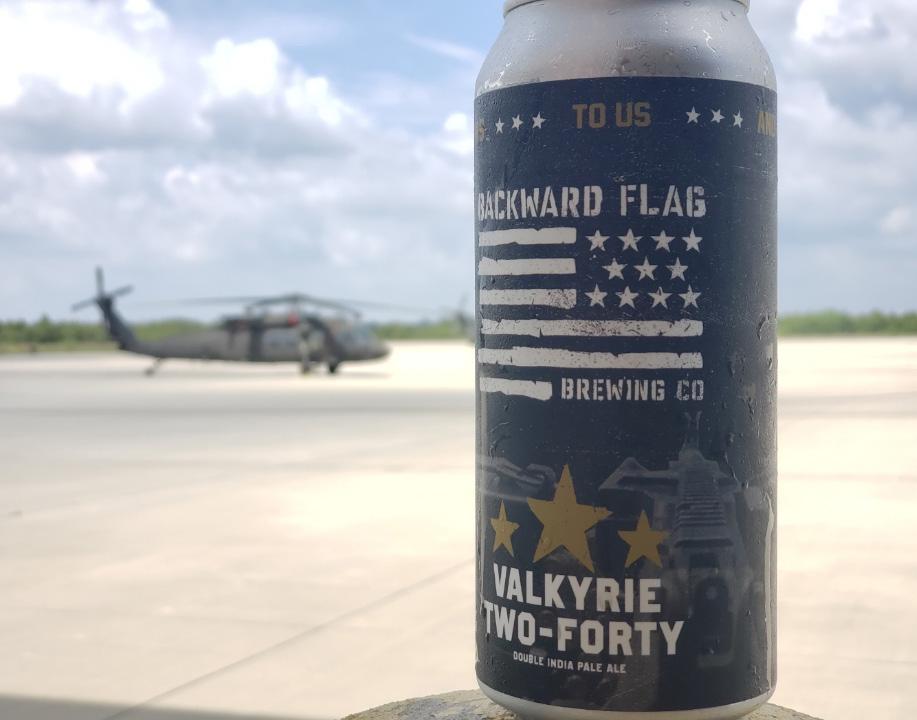

“In business, things never really ever go right or the way that you expected them to,” Fisher said. “The military does a good job of teaching us how to bounce back from those failures. You never just get to screw something up and just sit there and say, ‘I guess it’s never going to work out, I give up.”
The Army also helped both entrepreneurs be better leaders. And for Keel, staying in the military has had its perks in that regard. For times when he is activated, including recently for COVID-19 response efforts, he needs to train others to run things well in his absence.
“In the long run I think it helps you work on the business instead of in the business, which I think a lot of entrepreneurs struggle with,” he said. “The Army Reserve forces that on me a little bit, and I think there are some positives to that.”
A deadly pandemic, a Category 5 hurricane and two earthquakes. While this sounds like cataclysms from the Old Testament — it’s not. Puerto Rico has been dealing with a range of natural disasters for the past three years.
In the center of them all is the Puerto Rico National Guard, stepping up to the challenges each provides.
“It’s certainly showing that the Puerto Rico National Guard is a flexible and adaptable force,” Maj. Gen. José Reyes, adjutant general, said.
The COVID-19 pandemic disrupted the lives of just about every American. The mantra of elected officials has been, “Flatten the
curve,” meaning stop the spread of the virus. PRNG is doing its part to accomplish that by conducting medical evaluations of everyone entering Puerto Rico.
Earlier this year, PRNG and other federal and state agencies started screening incoming passengers at the international airport in San Juan by installing 11 infrared cameras that measure a person’s body temperature.

If a passenger has a temperature of 100.3° or over, they are immediately taken to a triage area and tested for COVID-19.
This is a 24/7 operation with about 260 PRNG members participating — roughly 60 are assigned to each six-hour shift.
In addition to military personnel, 150 students from Puerto Rico’s four medical schools have volunteered for this mission as well.
This actually worked as an unintentional recruitment campaign when four of them decided to join the PRNG. One of them is 2nd Lt. Laiza Rivera.
The 27-year-old says she was going stir-crazy being home all day because of the lockdown so she decided to volunteer at the airport. Rivera, whose major is ophthalmology, was already in the process of joining but inspired the other three student-volunteers to join as well.
PRNG has similar operations at other ports of entry.
Puerto Rico National Guard member takes the temperature of an incoming traveler at Luis Muñoz Marín International Airport in San Juan, Puerto Rico. Photo by Staff Sgt. Marimar Rivera.PRNG’s ability to adapt is illustrated in its revised plan for annual training. Ordinarily, large groups of personnel would attend exercises at the national training center in California, as well as another location in Louisiana. Not this year. In an effort to practice social distancing, those exercises will be modified to be conducted in smaller groups at Camp Santiago in Puerto Rico.
Additionally, classes that would normally be held in a conference room have switched to video conferencing.
In 2017, Hurricane Maria devastated Puerto Rico.
Under Reyes’ command, the island’s combined military forces provided its residents with just about everything they needed.
They provided MPs to the local police departments to maintain law and order; engineers cleared hundreds of miles of debris from roadways; and they conducted search and rescue operations in flooded communities and evacuated stranded citizens. The Army aviation unit conducted countless flights to and from the center of the island (its most rural and isolated area) to deliver food, water and emergency supplies.
Puerto Rico still hasn’t fully recovered from the hurricane and the 56 year-old general predicts that won’t happen for another 10 to 12 years.
If the hurricane wasn’t bad enough, Puerto Rico was shaken by two major earthquakes in January. There were 10,000 people who either partially or
completely lost their homes.
Reyes, who was born and raised in Puerto Rico, presented a plan to Governor Wanda Vázquez Garced to relocate these refugees. PRNG then established five major camps, each with a capacity of about 1,700. In partnership with FEMA and other agencies, they relocated over 10,000 people in 56 days.
While no one can predict when an earthquake will occur, there is an established hurricane season for the Caribbean and it’s happening now.
Presidential Directives Nos. 8 and 9, states and territories are required to conduct preparatory training in response to the threats that pose the greatest risk to national security, including natural disasters.

PRNG is on it conducting emergency management exercises for hurricanes, earthquakes,
pandemics and even tsunamis with all 78 municipalities on the island. Until last year, exercises were only for Category 5 hurricanes. The new exercises anticipate all these disasters happening concurrently.
Puerto Rico has had a lot thrown at it over the past three years and, in theory, it all could happen again. PRNG will be ready if it does.
Additionally, Reyes knows Guard units from other states, as well as additional DOD personnel, has Puerto Rico’s back and will be there to support him.
Reyes came out of retirement to take on this command and he’s glad he did.
“It’s a tremendous honor to command the Puerto Rico National Guard, eight-five hundred strong, fully committed men and women with an unbreakable sense of service towards the people of Puerto Rico and our nation,” he said. “I’m very proud of each one of them.”
Laiza Rivera, a medical student at Central Caribbean University, took the oath of office to become a 2nd Lt. in the Puerto Rico National Guard on April 2. Here she signs her enlistment contract as Gen. José Reyes looks on. Photo by First Sgt. Luis E. Orengo.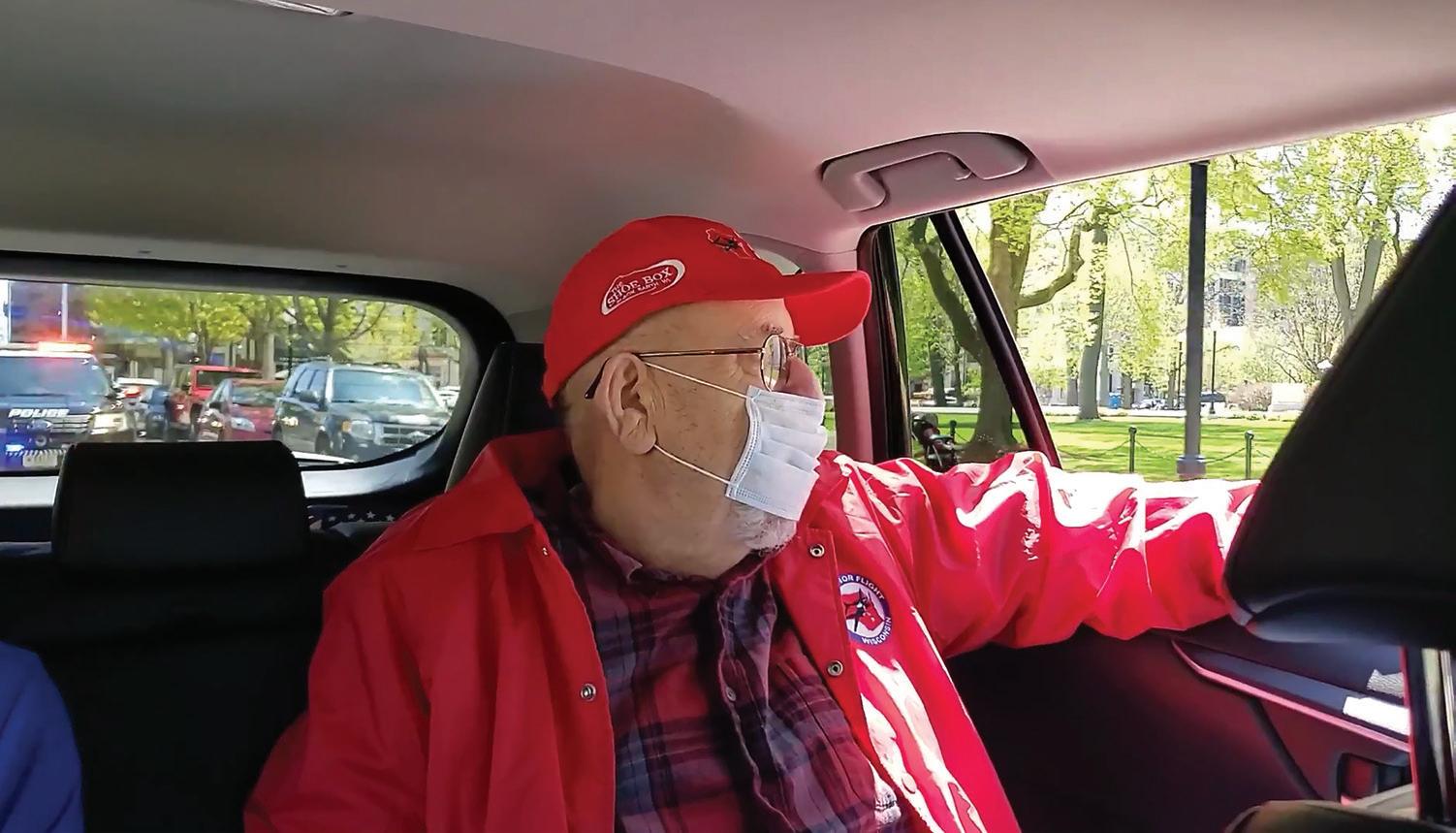 By Susan Malandrino
By Susan Malandrino
A pandemic couldn’t stop hospital staff from delivering the proper show of support for a Vietnam veteran.
After 18 months of planning, Wesley Buss was looking forward to taking a long-awaited honor flight. Illness and COVID-19 forced him to reschedule plans on three separate occasions, eventually causing permanent cancellation of the trip. Instead of being a story ending in disappointment, healthcare workers and members of his local community gathered together to pull off a patriotic surprise that celebrated his service, showered him with love and helped his spirits soar when he left the hospital to enter hospice care at home.
Wesley, a Wisconsin resident, served more than three decades in uniform — first in the Navy, then the Army National Guard, followed by career with the Wisconsin Capitol Police.
Derek Buss, Wesley’s son, says his dad is not used to being the center of attention.
“He’s a humble guy, this is not his style,” Derek said.
The idea for a celebration of service came when ICU nurse Vanessa Pierce spent time with Wesley as a patient at SSM Health St. Mary’s Hospital in Madison, Wisconsin.
“We got to talking about his service in Vietnam and how vets weren’t celebrated upon their return back then,” she said. “I thought it would be really good to clap for him and his service.”
Earlier in May, when the hospital wrapped up Health Care
Appreciation Week, Pierce says, “it got me thinking about giving back to others and how this is how Wesley had spent his entire career.”
Susan Leet, a chaplain at the hospital, joined in on the plan.
“People had been so gracious in thanking us. It was our time to pay it forward and, boy, did it feel good,” Leet said.
She began working the phones to get more people involved in the celebration.
“Everyone just adores Wesley,” Leet explained. “When I reached out to the Wisconsin Capitol Police, they were excited to help as were the Badger Honor Flight volunteers.”
It turns out that Wesley and his late wife were active volunteers with their state’s chapter of Honor Flight — a nonprofit that works to transport America’s veterans to the nation’s capital to visit the memorials dedicated to honoring those who have served and sacrificed.
“Both mom and dad loved the cause and loved what they were doing to help coordinate flights for veterans,” Derek said.
After volunteering for the organization for more than a decade, Wesley had yet to complete his own flight. Preparations for the local event continued and the family got involved as did more members of the community.
“Everyone just got excited and it just blossomed into this huge thing,” Leet said about the surprise.
The planning came to fruition in mid-May when Wesley was discharged from the hospital. Upon exiting his room, he found the
halls of the hospital packed with staff, waving American flags and clapping for his service. Outside the hospital, the celebration continued with Capitol Police saluting him and playing the national anthem. Volunteers from the Badger Honor Flight presented him with an award. From there, a police escort drove the family to the capitol building, where officers were stationed on every corner to offer salutes. The tour ended at the governor’s mansion, where Governor Tony Evers and First Lady Kathy Evers waited outside to wave and salute his service.
“Dad found that really funny and likes to say, ‘I didn’t vote for him but sure appreciated it,” Derek said with a chuckle. “In the video of the event, it is hard to tell underneath his mask, but dad is grinning from ear to ear. Dad’s not one to show emotion but he was tickled. This was one of the best days of his life.”
Honor Flights remain suspended until September 1 as a precaution for the safety of the veterans’ health.

“Every year, the Honor Flight Network takes more than 20,000 veterans to Washington, DC to see the national memorials built in their honor. Eligible veterans include those who served in World War II, the Korean War, Vietnam War, intermediary operations, and in special cases of terminal illness or injury, veterans of more recent service. Unfortunately, the vast majority of the veterans we serve fall into the CDC’s high-risk category. Many of the veterans also live in community settings, such as retirement homes or assisted living facilities, where the risk of spreading illness is extremely high. Honor Flight trips are often a once in a lifetime opportunity for America’s veterans, so the organization does its best to keep all trips on time and on
schedule. At the same time, Honor Flight’s highest priority during trips is to maintain the veterans’ safety,” according to a statement by the Honor Flight Network.
Thanks to the onlookers who heard Wesley’s story, he was able to have a personalized experience reflective of his contributions to the nation and his community.
“He’s someone who always has wanted to be of service. You don’t think about it much and the sacrifice that comes with service, but this celebration was a big reflection. Dad kept saying, ‘I’m a nobody; I don’t deserve this.’ Everyone who planned this surprise made it pretty clear he did,” Derek added.
If the COVID-19 crisis has taught any of us anything, it should be about the importance of resiliency. Resiliency is not something that just happens on its own. It takes work and it is something that must be developed.
In the military, we talk a great deal about readiness, especially in terms of personnel, equipment, and training. Leaders focus on readiness in order to be prepared at any time to fight and win our nation’s wars. We also know from history that it is difficult to predict where the next war will be, let alone when it will be. Thus, we continually work to develop the highest states of readiness we possibly can. It is about being ready for the unexpected. As the military focuses on readiness, families must also develop resiliency so they can overcome unexpected setbacks and challenges.
When I served as one of the deputy commanding generals at U.S. Army Europe, we talked about national resiliency — the ability of nations to weather storms and to bounce back from unforeseen and potentially damaging events. This means overcoming devasting incidents such as a natural disaster, terrorist attack, cyber intrusion, economic downturn, and similar events. Elements of national resiliency could include energy independence, cyber defense, a capable military, interagency cooperation, human rights, rule of law, and a strong economy.
Just as nations must work to develop national resiliency, families must do the same thing. That way if unforeseen and potentially destructive events occur, the family will be able to overcome the event and come out stronger than ever. The six aspects of family resiliency I will discuss are savings, education, internet access and competence, a supportive network of family and friends, spiritual strength, and health.
Families should strive to save at least 10% of their monthly income every month and if possible, invest another 10% of the household income. The goal should be to set aside at least six months of living expenses. Families must
guard against living at a level that prevents accumulating an amount that will help a family survive crises such as the one we are experiencing with COVID-19. Some families may see saving six months of living expenses as a daunting task. However, this does not have to happen overnight. When it comes to saving money remember it is about chipping away and saving little by little.
To increase savings, families must set a goal and then stay disciplined in order to reach that goal. It may take instituting some family austerity measures. Perhaps that means eating meatloaf instead of steak. Or, making dinner rather than ordering take-out every evening. Perhaps it means making your coffee at home rather than purchasing coffee at an expensive gourmet coffee shop. I think everyone gets the point I am trying to make.
Family leaders must place an emphasis on the importance of education. This does not necessarily mean formal education, but informal education is important too. This means encouraging members of the family to read, starting at an early age. Parents or guardians should make it a routine to read to young children. Also
allow children, as they get older, to read aloud. Books should be a fixture in the household and reading time should take precedence over TV time.
Parents and guardians should lead by example. Talk to the children about the training you are going through at work, educational endeavors you are pursuing and books you are reading. Try to bring thoughtful people into the lives of your children who have knowledge to share. Ensure your children stay involved with extracurricular activities in and out of school. Children and young adults could learn so much from these extra activities.
We are in the digital age. The internet and information technology have been instrumental in helping Americans get through the COVID-19 crisis. Having competency in using video conferencing platforms to communicate and learn is essential. Social media sites are also important networking and communications enablers. Several years ago, I was at a senior military leaders’ conference at West Point. The speaker who was a futurist told our group that if you do not have a presence on social media, you virtually do not exist. As one who believes there is no substitute for face-to-face contact, I do appreciate social media and other technology that could help us all stay connected, even when a world apart. Now in the age of COVID-19, someone just a few miles down the street could just as well be a continent away if we cannot connect with them virtually.
“For the strength of the Pack is the Wolf, and the strength of the Wolf is
the Pack,” so wrote Rudyard Kipling in “The Jungle Book”. Families must develop what I like to call “social fitness” by developing a dependable network of family and friends. Like the other imperatives of developing resiliency, this also takes work and does not just happen by itself.
The best way to develop a solid support network is by seeking ways to reach out to others and proactively assist others whenever you can. It is important to get involved in the community whether that be on a military post or out in the civilian community. There are many organizations for the family to get involved with including sports, scouting, and the Civil Air Patrol to name a few. It is not only the children who should be involved, but all these organizations also welcome adult leadership.
Resilient families tend to have a spiritual foundation. While formal religion does play an important role in the lives of many, one does not have to be connected to such in order to have spiritual well-being. However, I believe families need to have a basis for their character development and have a sense of the values and principles they stand for.
To me, spiritual strength as it relates to families is about instilling a feeling that there is something greater than ourselves. There also must be a sense of charity and a giving attitude. Being charitable and assisting others has a way of developing inner peace and allows a family to feel good about themselves and develop confidence.
The heads of a household could lead the family to a place of spiritual well-being by reading verses from various religious teachings or
inspirational writings aloud and allowing for time to discuss those readings or to think quietly and meditate on what was heard.
A family builds resiliency by encouraging healthy-eating habits and encouraging physical fitness, activity, and sports. I think COVID-19 has taught many that one is more likely to survive a pandemic if you are not in a high-risk health category. Of course, many may find themselves in a high-risk category through no fault of their own, such as the elderly or someone who has a genetic condition.
However, there are those who have placed themselves in highrisk categories that could have been avoided by living a healthier lifestyle. Families need to be accountable for the actions they take regarding eating habits, physical activity, and overall health. When a family engages in outdoor activities together such as hiking, cycling, and sports, it not only makes for a healthy body but also makes great memories too.
Financial security and savings, education, internet access and computer savvy, a supportive network, spiritual strength, and health are all part of developing greater resilience within a family unit. There are certainly other elements too. However, if families focus on those six things the family will develop the grit to face unexpected and uncertain events in life. Focusing on family resiliency will also provide an example to the children, so as they move into adulthood, they could build resiliency in their own families as they take on those responsibilities.
As the number of states impacted by the coronavirus pandemic increased, so did the number of soldiers activated to respond. Mobilizing personnel from the Army Reserve and Army National Guard meant civilian companies would have a deficit in its workforce, a known commitment attached to employers who hire talent from the reserve component. It can also lead to economic hardship for those who take a pay cut to fulfill military obligations — except for employees working in an environment with pro-military employment policies.
PricewaterhouseCoopers (PwC), as an example, employs over 1,500 veterans — with several activated as part of the COVID-19 response. In addition to maintaining the jobs of those called to active duty, PwC compensates them with 100% of their pay. Within its ranks, soldiers received notification they would be serving in various capacities, such as:
• Providing epidemiological intelligence
• Deploying medical resources
• Helping stage combat hospitals in communities around the country
Capt. Paul Spranger, a PwC Senior Associate, is a staff officer with the Indiana Army National Guard. At the onset of the COVID-19 response, he said several of his colleagues were called to service in one capacity or another, leading different project teams to adjust responsibilities to accommodate them getting pulled in. At the time, Spranger was preparing epidemiological threat intelligence reports to advise his team on secondary and tertiary effects on disease transmission models.
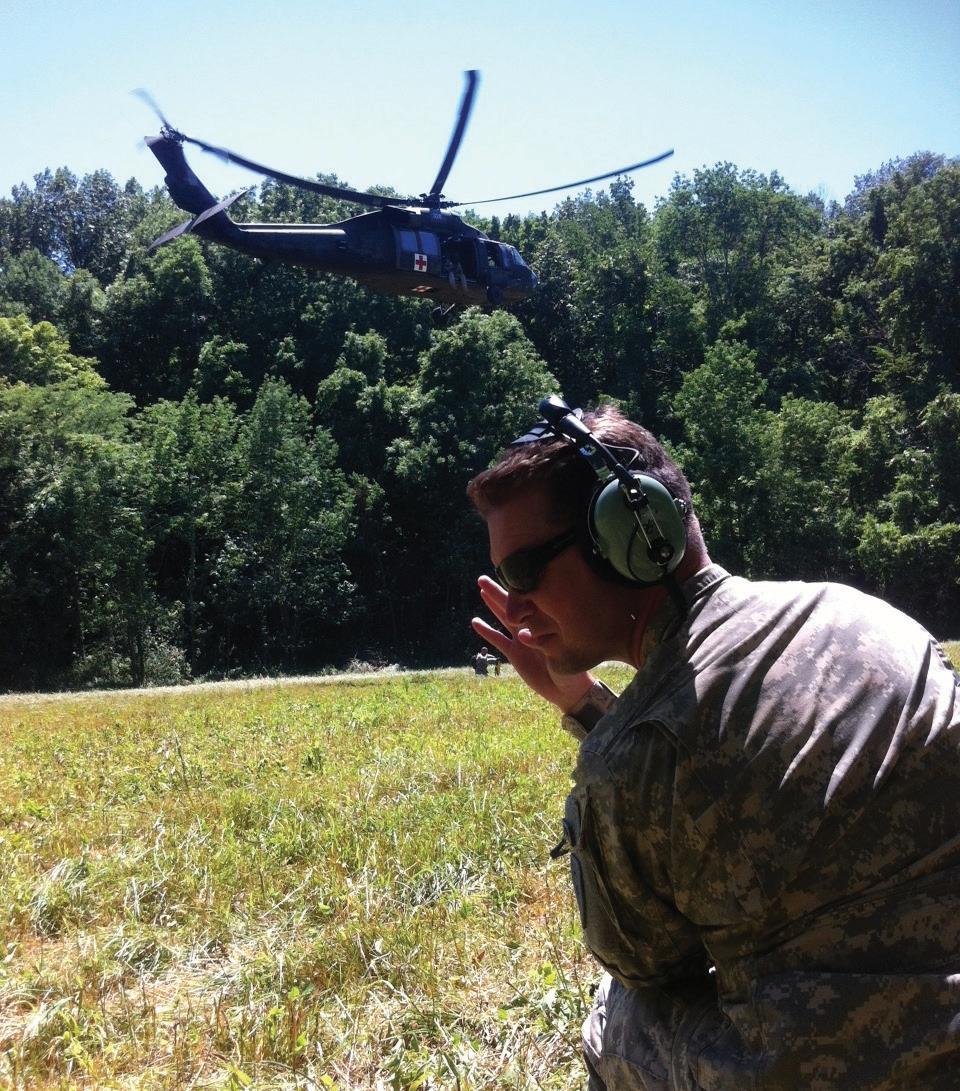
He heard portions of his unit were being activated, then got the call himself for an operations officer-incharge role for a patient transport task force.
“We have a number of areas within the state of Indiana that have limited capacity in order to transport patients from one care facility to another and as a consequence, essentially they needed additional help to move some of those patients in the event that the hospital system couldn’t facilitate the additional surge in patients,” Spranger said. “So, what I’m doing day to day is planning to prepare all of our different elements and all the different districts in the state of Indiana that have this need, and pre-
positioning ambulance assets around the state. And then managing their movements and ensuring those areas have the coverage they need.”
He says soldiers are “ready to respond” to this sort of event.
“I’ve always been in a staff officer type role, and so as a consequence this is very similar — one of the essential elements of an operation that really never really changes. It’s just a lot of administrative, logistical, lots of planning and things like that, so it’s just a matter of putting the right talent — just like the civilian sector — in the right places to do the job that they know how to do,” he said.
PwC launched a Veteran’s Affinity Network in 2008 to support veterans in the workplace. The group, which is led by Lt. Col. Tim Stoner, has grown to more than 1,000 active members and 20 chapters. He said having such a resource makes transition easier on employees leaving active duty or returning to a civilian job after a combat deployment.
Stoner, a PwC Partner, is the commander of the 55th Medical Detachment in Indianapolis, Indiana. Through his civilian
position at PwC he works with clients in cybersecurity, but it is aligned to the healthcare vertical. He sees crossover between his careers in and out of uniform.
“Both of those things have strong synergies with the military. From a cybersecurity perspective, everything we do in the military really revolves from a security perspective from three pillars: information security, operational security, and physical security. So, I think a lot of our military members have that in their DNA just based on service to the country and I think that plays well on my civilian career,” Stoner said.
Throughout the COVID-19 response, he had a dual-capacity role with evening calls and weekend duty to prepare the unit he commands for stateside support. He mobilized three teams to three different hot spots to stage Combat Support Hospitals on the east and west coasts. Logistically, he said, this mobilization “has been very easy” because FEMA had the lead on the national response.

Stoner has served in the Army for 32 years across all components, and says this pandemic is unlike anything he has seen.
“It’s unique. I’ve been called up and served many times — been overseas, been mobilized, been deployed. It’s usually with something that’s maybe known or seen, or is traumatic in result — that’s maybe more visible or palpable, if that makes sense,” he said. “We (the military) are great at emergency medicine and trauma
medicine, and things like that, but this is obviously a different type of threat where it’s unlike anything I’ve done. It’s less traumatic and dramatic than maybe some of my combat tours, but this is equally as critical and life-taking, as we all know.”
Stoner adds the support from PwC has been “tremendous,” at every step from local levels up the chain to the CEO.
“We have a very supportive military lead policy as well as great things that support our folks, from flexible work arrangements, certainly to child care, emergency support and elder care support for families in need. Mental health resources and capabilities. I’ve never been in a consultancy that has this level of support for their people.”
Visit https://www.pwc.com/us/en/careers/why-pwc/military-veterans.html
 By Natalie Gross
By Natalie Gross
That means scheduling calls or meetings late into the evenings — often with young professionals working day jobs, or even students at the mercy of parents’ schedules.
But now that the coronavirus pandemic has kept most people at home, Hauser’s job as a line recruiter for the Air Force Reserve in Columbia, South Carolina, is considerably more efficient, he said.
Since replacing face-to-face meetings with online video chats through Zoom, he’s able to spend more time making connections, rather than traveling to them. Family members can listen in on his conversations with students, cutting down on additional meetings to answer parents’ questions. And would-be after-hours meetings with working adults don’t have to be so late in the day.
“Now, they don’t have to miss work. They don’t have to try to commute or take time off,” Hauser said in an interview. “You can eliminate that travel time and satisfy those customers on a lunch break, if they can step away. So, it’s really created a unique way for us, in my opinion, to reach more applicants.”
Many people seem to prefer it, too.
“If I can eliminate those face-toface things and still give them the information, they need to make an educated decision, I think it’s advantageous to all parties involved — myself included,” he said.
Air Force Reserve recruiters like Hauser assessed 7,323 enlisted
airmen, 982 line officers, 361 health professionals and 50 chaplains during the last fiscal year, according to figures provided by the Air Force Recruiting Service. Since the start of remote operations in response to COVID-19, there has been a 10% drop in accessions, or the number of applicants that have completed the process and sworn into the service, compared to this time last year.
Hauser said he noticed a lull in his workflow toward the beginning of the COVID-19 crisis and was not permitted to send new recruits through the Military Entry Processing Station in his area for the month of April. But things are gradually returning to normal, and interest has remained steady.
As in previous years, seniors graduating from high school are considering their futures and may look to the military as a way to pay for college, he said. Sudden job losses have also been a motivator behind some leads, particularly among veterans who had already planned to continue serving but had not yet initiated the process.
Hauser said he’s able to complete every step of the process with an applicant without ever having to meet in person, including the oath.
Lt. Col. Olivia Nelson, commander of the 351st Recruiting Squadron, presided over one of Hauser’s virtual ceremonies. She says there are real perks to conducting enlistments via Zoom. Whereas before, young recruits could invite local family members to watch them swear in,
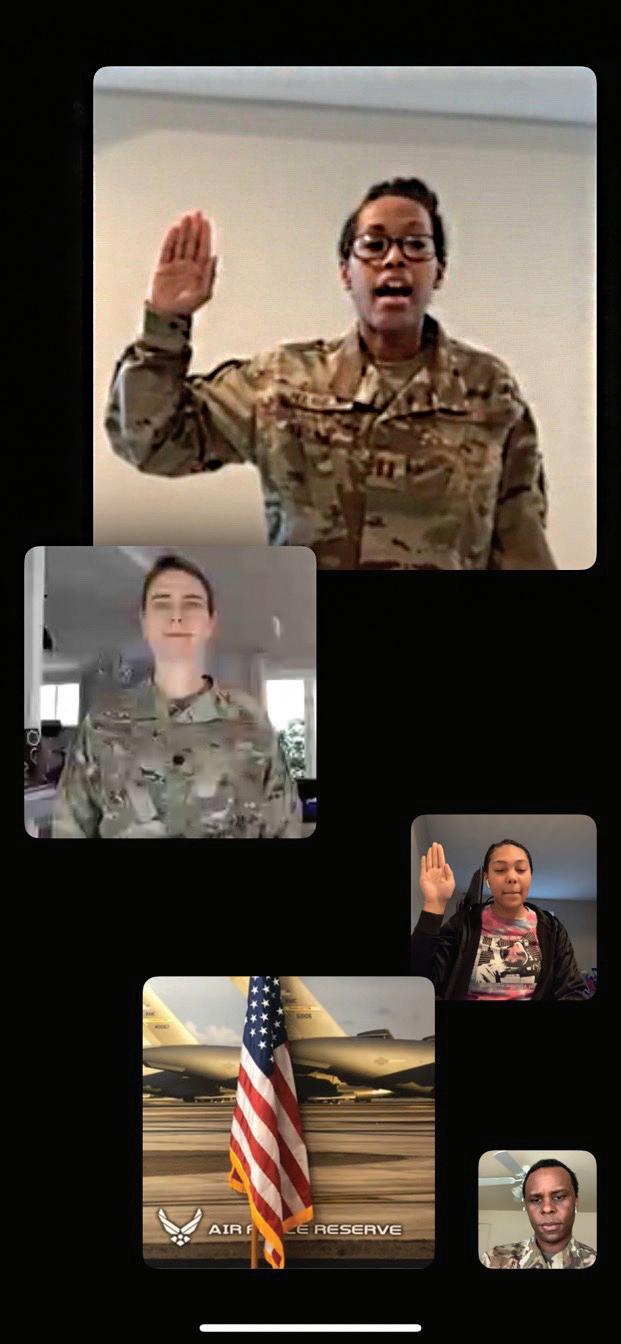
now, for the first time in her career, “they’re able to share that moment with a much larger range of people that are really important to them and that have influenced their values in a way that made them want to serve to begin with,” Nelson said. “Crisis situations are always sort of a great forcing function to help us grow and expand and then we realized that there are these things we wish we had always done or wish we had realized would be a wonderful addition to our toolkit. “
“We’re all figuring out this new normal and what’s best and what’s safest,” Hauser said.
Meanwhile, one thing’s for sure: His toolkit as a recruiter will include virtual options from now on — even after it’s safe to meet with prospective recruits once more.
To be a successful military recruiter, one has to be available during odd hours, according to Air Force Tech. Sgt. Kyle Hauser.

